同济大学:《水资源管理》课程教学资源(教案讲义)08 Case in Lake Victoria, East Africa
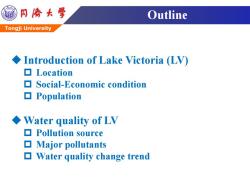
月大学 Outline Tongji University Introduction of Lake Victoria (LV) ▣Location Social-Economic condition ▣Population ◆Water quality of LV ▣Pollution source ▣Major pollutants Water quality change trend
Tongji University Outline ◆Introduction of Lake Victoria (LV) Location Social-Economic condition Population ◆Water quality of LV Pollution source Major pollutants Water quality change trend

同海大学 Tongji University 1.Introduction of Lake Victoria (LV
Tongji University 1. Introduction of Lake Victoria (LV)
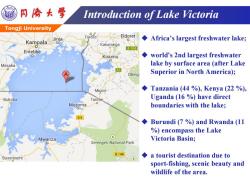
@月大学 Introduction of Lake Victoria Tongji University Eldoret Jinia ororo Africa's largest freshwater lake; Kampala Kakamega A104 Entebbe Kisumu world's 2nd largest freshwater Masaka lake by surface area (after Lake Oleng Superior in North America); Tanzania(44 %)Kenya (22 %) Bukoba Uganda(16 %have direct Musoma boundaries with the lake; 86 Burundi(7 %and Rwanda (11 %)encompass the Lake Mwanza Victoria Basin; Serengeti National Park B144 Buseresere a tourist destination due to sport-fishing,scenic beauty and wildlife of the area
Tongji University ◆ Africa’s largest freshwater lake; ◆ world's 2nd largest freshwater lake by surface area (after Lake Superior in North America); ◆ Tanzania (44 %), Kenya (22 %), Uganda (16 %) have direct boundaries with the lake; ◆ Burundi (7 %) and Rwanda (11 %) encompass the Lake Victoria Basin; ◆ a tourist destination due to sport-fishing, scenic beauty and wildlife of the area. Introduction of Lake Victoria
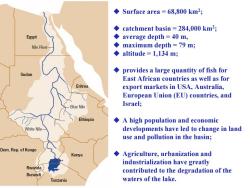
Surface area 68,800 km2; catchment basin 284,000 km2; Egypt ◆ average depth 40 m, Nile River ◆maximum depth=79m; ◆altitude=1,134m; Sudan provides a large quantity of fish for East African countries as well as for Eritrea export markets in USA,Australia, European Union(EU)countries,and Blue Nile Israel; Ethiopia A high population and economic White Nile developments have led to change in land use and pollution in the basin; Dem.Rep.of Kongo Kenya Agriculture,urbanization and industrialization have greatly Rwanda contributed to the degradation of the Burundi Tanzania waters of the lake
◆ Surface area = 68,800 km2 ; ◆ catchment basin = 284,000 km2 ; ◆ average depth = 40 m, ◆ maximum depth = 79 m; ◆ altitude = 1,134 m; ◆ provides a large quantity of fish for East African countries as well as for export markets in USA, Australia, European Union (EU) countries, and Israel; ◆ A high population and economic developments have led to change in land use and pollution in the basin; ◆ Agriculture, urbanization and industrialization have greatly contributed to the degradation of the waters of the lake
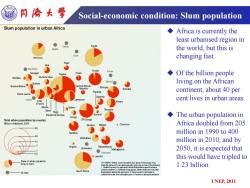
同傍大学 Social-economic condition:Slum population Slum population in urban Africa Africa is currently the least urbanised region in the world,but this is by changing fast. ◆Of the billion people living on the African continent,about 40 per cent lives in urban areas The urban population in Africa doubled from 205 million in 1990 to 400 million in 2010,and by 2050,it is expected that this would have tripled to 1.23 billion UNEP,2011
Tongji University Social-economic condition: Slum population UNEP, 2011 ◆ Africa is currently the least urbanised region in the world, but this is changing fast. ◆ Of the billion people living on the African continent, about 40 per cent lives in urban areas. ◆ The urban population in Africa doubled from 205 million in 1990 to 400 million in 2010, and by 2050, it is expected that this would have tripled to 1.23 billion
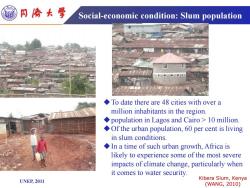
动同儕大学 Social-economic condition:Slum population To date there are 48 cities with over a million inhabitants in the region population in Lagos and Cairo>10 million. Of the urban population,60 per cent is living in slum conditions In a time of such urban growth,Africa is likely to experience some of the most severe impacts of climate change,particularly when it comes to water security. UNEP,2011 Kibera Slum,Kenya (WANG,2010)
Tongji University Kibera Slum, Kenya (WANG, 2010) Social-economic condition: Slum population UNEP, 2011 ◆To date there are 48 cities with over a million inhabitants in the region. ◆population in Lagos and Cairo > 10 million. ◆Of the urban population, 60 per cent is living in slum conditions. ◆In a time of such urban growth, Africa is likely to experience some of the most severe impacts of climate change, particularly when it comes to water security
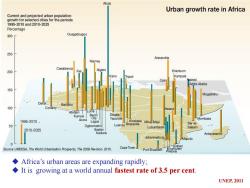
Abuja Urban growth rate in Africa Current and projected urban population growth for selected cities for the periods 1995-2010and2010-2025 Percentage 300F Ouagadougou 250 Alexandria Niamey Casablanca 200 Khartoum ripol Kampala Nairobi Addis Ababa 150 Mogadishu Dakar 100 Cor ome Benin Douala tw 1995-2010 Accra Yaounde Mombasa Lagos IKinshasa Mbuj-Mayi Luanda Brazavile Dar es Ogbomosho 2010-2025 Lubumbash Salaam Kaduna Jonannesburo 0 Durban Source:UNDESA,The World Urbanisation Prospects,The 2009 Revision,2010. Cape Town Africa's urban areas are expanding rapidly; It is growing at a world annual fastest rate of 3.5 per cent UNEP,2011
Tongji University UNEP, 2011 ◆ Africa’s urban areas are expanding rapidly; ◆ It is growing at a world annual fastest rate of 3.5 per cent
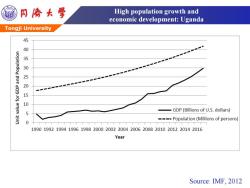
同©大学 High population growth and economic development:Uganda Tongji University 45 40 35 25 20 15 Joj anjen iun 10 -GDP (Billions of U.S.dollars) 5 ----Population (Millions of persons) 0 19901992199419961998200020022004200620082010201220142016 Year Source:IMF,2012
Tongji University High population growth and economic development: Uganda Source: IMF, 2012
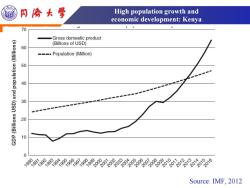
@月大学 High population growth and economic development:Kenya 70 Gross domestic product (Billions of USD) 60 --Population (Million) 50 40 pue(asn 30 20 10 0 1996 2002008 201 Source:IMF,2012
Tongji University Source: IMF, 2012 High population growth and economic development: Kenya
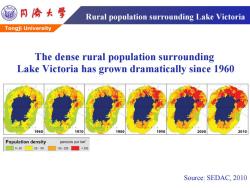
同海大学 Rural population surrounding Lake Victoria Tongji University The dense rural population surrounding Lake Victoria has grown dramatically since 1960 1960 1970 1980 1990 2000 2010 Population density persons per km' ☐0-25☐25-100☐10-250☐2250 Source:SEDAC,2010
Tongji University Rural population surrounding Lake Victoria The dense rural population surrounding Lake Victoria has grown dramatically since 1960 Source: SEDAC, 2010
按次数下载不扣除下载券;
注册用户24小时内重复下载只扣除一次;
顺序:VIP每日次数-->可用次数-->下载券;
- 同济大学:《水资源管理》课程教学资源(教案讲义)06 Water Resource Management - Sponge City.pdf
- 同济大学:《水资源管理》课程教学资源(教案讲义)05 Trans-boundary water resources management.pdf
- 同济大学:《水资源管理》课程教学资源(教案讲义)04 Water Quality Modeling、Reactions & Transport、Dissolved Oxygen Modeling in Rivers、Eutrophication.pdf
- 同济大学:《水资源管理》课程教学资源(教案讲义)03 Energy-water nexus in urban water systems.pdf
- 同济大学:《水资源管理》课程教学资源(教案讲义)02 Water Resources Management Tool - Water Footprint(WF).pdf
- 同济大学:《水资源管理》课程教学资源(教案讲义)01 Introduction to water resources(负责人:王洪涛).pdf
- 同济大学:《给水工程原理与技术》课程电子教案(课件讲稿)Mixing Coagulation - Flocculation.pdf
- 同济大学:《给水工程原理与技术》课程电子教案(课件讲稿)Advanced Oxidation.pdf
- 同济大学:《给水工程原理与技术》课程电子教案(课件讲稿)Municipal Water Purification Plant.pdf
- 同济大学:《给水工程原理与技术》课程电子教案(课件讲稿)Membrane technology.pdf
- 同济大学:《给水工程原理与技术》课程电子教案(课件讲稿)Filtration.pdf
- 同济大学:《给水工程原理与技术》课程电子教案(课件讲稿)Sedimentation.pdf
- 同济大学:《固体废物处理与资源化》课程教学资源(讲稿)Leachate and Landfill Gas.pdf
- 同济大学:《固体废物处理与资源化》课程教学资源(讲稿)Incineration, pyrolysis & gasification.pdf
- 同济大学:《固体废物处理与资源化》课程教学资源(讲稿)Biogas – a way to solve sanitation problems.pdf
- 同济大学:《固体废物处理与资源化》课程教学资源(讲稿)Waste processing technologies application.pdf
- 同济大学:《固体废物处理与资源化》课程教学资源(讲稿)Introduction on Solid Waste.pdf
- 《固体废物处理与资源化》课程教学资源(文献资料)LANDFILL MANUALS LANDFILL SITE DESIGN.pdf
- 《固体废物处理与资源化》课程教学资源(文献资料)The anaerobic digestion process of biogas production from food waste - Prospects and constraints.pdf
- 《固体废物处理与资源化》课程教学资源(文献资料)Efficient reduction of antibiotic residues and associated resistance genes in tylosin antibiotic fermentation waste using hyperthermophilic composting.pdf
- 同济大学:《水资源管理》课程教学资源(教案讲义)07 Brief Introduction to Integrated Water Environment Rehabilitation、A Big Picture:China City’s Effort to Improve River Water Quality with Shanghai as a Case、River water quality assessment and water pollution sources survey.pdf
- 上海海洋大学:海洋生态与环境学院课程教学大纲汇编(2018版).pdf
- 兰州交通大学:《环境保护与可持续发展》课程教学资源(大纲讲义)教学大纲 Environmental protection and sustainable development.pdf
- 兰州交通大学:《环境保护与可持续发展》课程教学资源(试卷习题)试卷1.doc
- 兰州交通大学:《环境保护与可持续发展》课程教学资源(试卷习题)试卷2.doc
- 兰州交通大学:《环境保护与可持续发展》课程教学资源(试卷习题)试卷3.doc
- 兰州交通大学:《环境保护与可持续发展》课程教学资源(试卷习题)试卷4.doc
- 兰州交通大学:《环境保护与可持续发展》课程教学资源(试卷习题)试卷5.doc
- 兰州交通大学:《环境保护与可持续发展》课程教学资源(授课教案)第一章 地球环境的基本特征.doc
- 兰州交通大学:《环境保护与可持续发展》课程教学资源(授课教案)第二章 生态系统.doc
- 兰州交通大学:《环境保护与可持续发展》课程教学资源(授课教案)第三章 人口与资源.doc
- 兰州交通大学:《环境保护与可持续发展》课程教学资源(授课教案)第四章 资源短缺.doc
- 兰州交通大学:《环境保护与可持续发展》课程教学资源(授课教案)第五章 环境污染 Environmental Pollution.doc
- 兰州交通大学:《环境保护与可持续发展》课程教学资源(授课教案)第六章 生态破坏 Ecology Damage.doc
- 兰州交通大学:《环境保护与可持续发展》课程教学资源(授课教案)第七章 全球环境问题.doc
- 兰州交通大学:《环境保护与可持续发展》课程教学资源(授课教案)第八章 可持续发展的基本理论.doc
- 兰州交通大学:《环境保护与可持续发展》课程教学资源(授课教案)第九章 可持续发展战略的实施途径.doc
- 兰州交通大学:《环境保护与可持续发展》课程教学资源(授课教案)第十章 环境伦理观.doc
- 兰州交通大学:《环境保护与可持续发展》课程教学资源(授课教案)第十一章 环境规划与管理.doc
- 兰州交通大学:《环境保护与可持续发展》课程教学资源(授课教案)第十二章 环境管理的法律手段.doc
